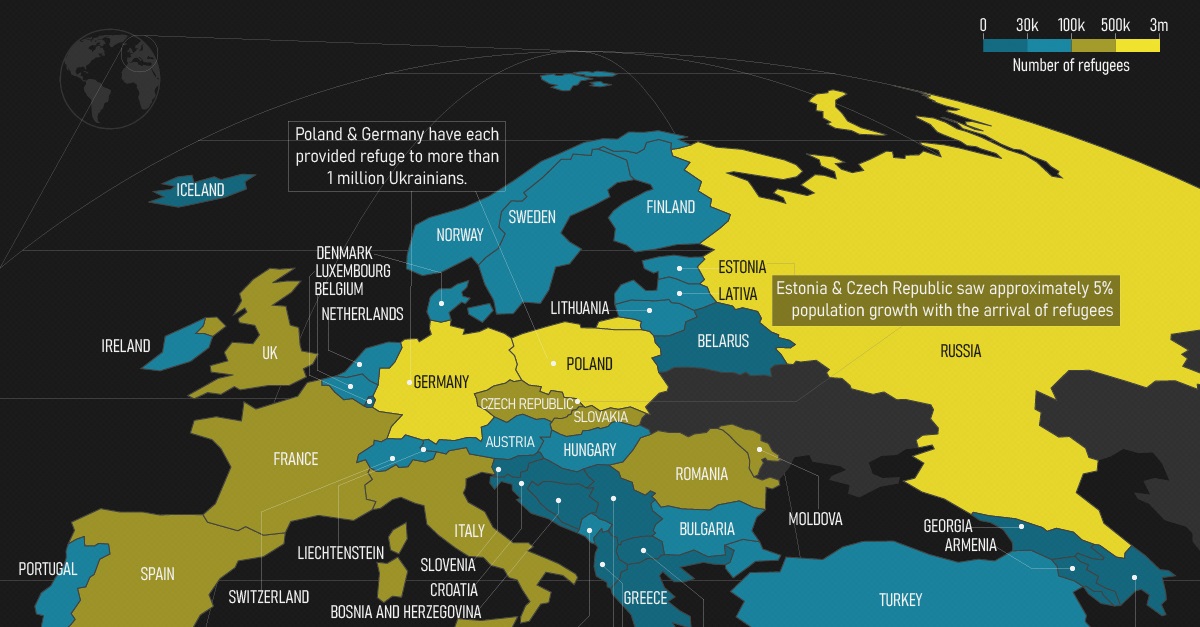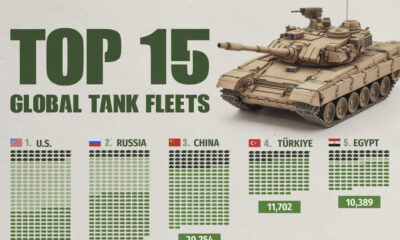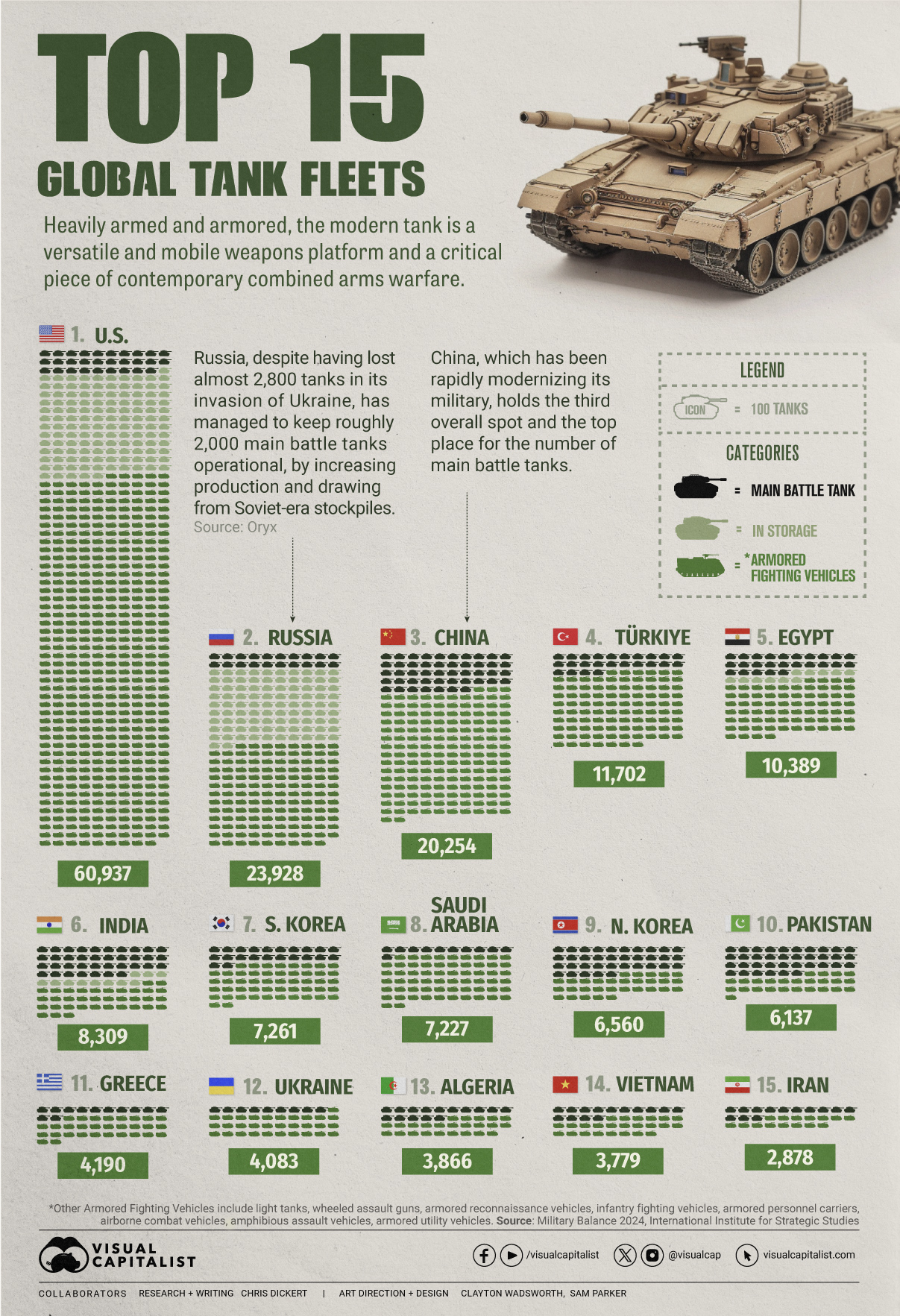War
Mapped: Ukrainian Refugee Destinations by the Numbers
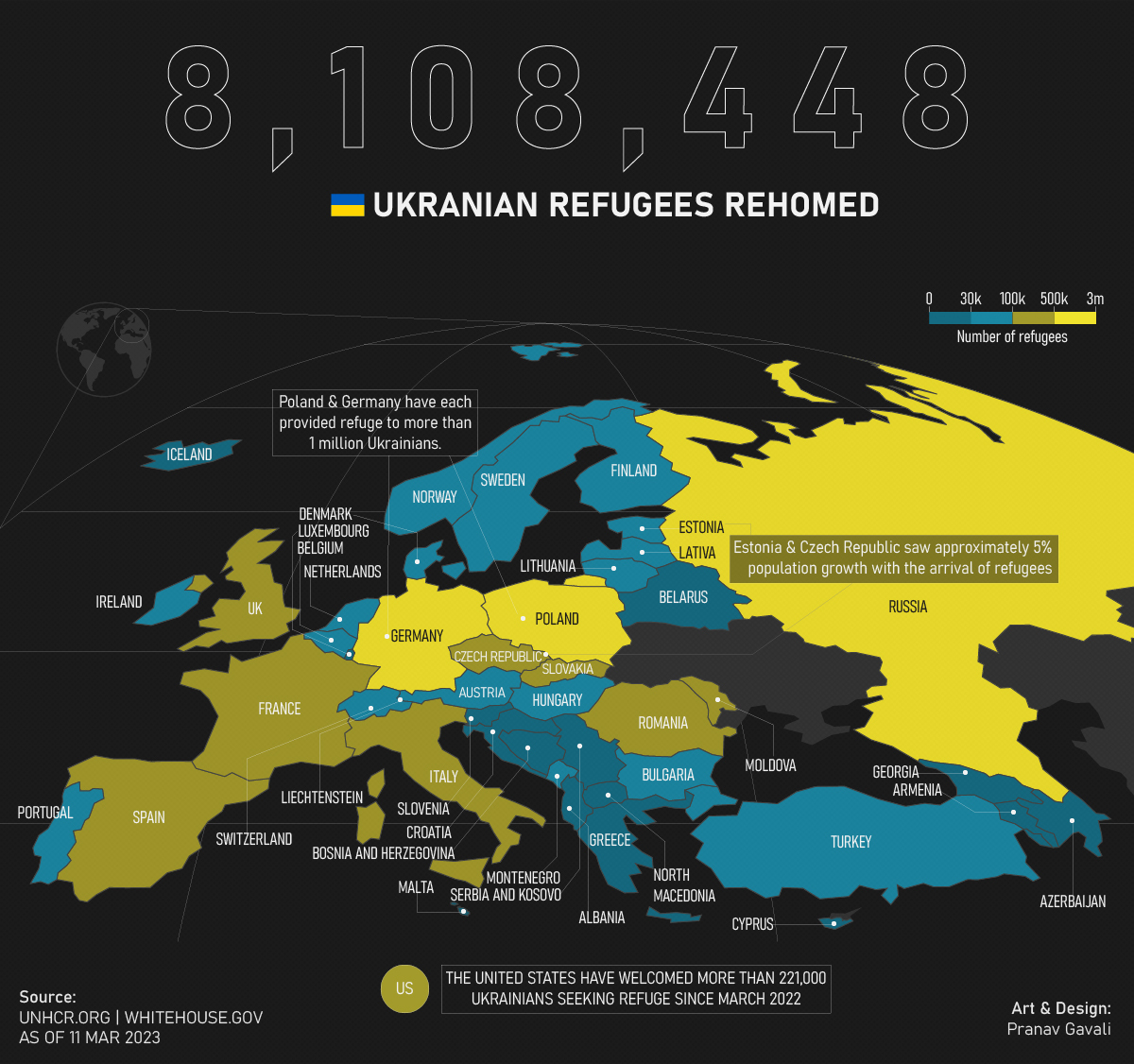
Mapped: Ukrainian Refugee Destinations by the Numbers
It’s been more than a year since Russia invaded Ukraine and forced refugees to seek destinations for new (or temporary) homes.
This ongoing conflict has resulted in one of the worst humanitarian crises in Europe in recent times. Millions of people have fled their homes and sought temporary or permanent asylum in countries across Europe, and the world.
This map by Pranav Gavali uses UNHCR data as of March 11, 2023 to highlight the countries that became Ukrainian refugee destinations.
Top Refugee Destinations in Europe
Over eight million Ukraine residents have found shelter outside of the country since February 2022, primarily in Europe.
| Country | Ukrainian Refugees |
|---|---|
| 🇷🇺 Russia | 2,852,395 |
| 🇵🇱 Poland | 1,564,711 |
| 🇩🇪 Germany | 1,055,323 |
| 🇨🇿 Czechia | 497,217 |
| 🇮🇹 Italy | 171,739 |
| 🇪🇸 Spain | 168,654 |
| 🇬🇧 United Kingdom | 164,500 |
| 🇫🇷 France | 118,994 |
| 🇸🇰 Slovakia | 111,173 |
| 🇷🇴 Romania | 110,921 |
| 🇲🇩 Moldova | 107,728 |
| 🇹🇷 Türkiye | 95,874 |
| 🇦🇹 Austria | 94,343 |
| 🇳🇱 Netherlands | 89,730 |
| 🇨🇭 Switzerland | 81,862 |
| 🇮🇪 Ireland | 75,260 |
| 🇱🇹 Lithuania | 75,197 |
| 🇧🇪 Belgium | 68,869 |
| 🇪🇪 Estonia | 67601 |
| 🇵🇹 Portugal | 58,242 |
| 🇸🇪 Sweden | 52,325 |
| 🇧🇬 Bulgaria | 50,112 |
| 🇫🇮 Finland | 47,067 |
| 🇳🇴 Norway | 41,519 |
| 🇩🇰 Denmark | 40,613 |
| 🇱🇻 Latvia | 35,243 |
| 🇭🇺 Hungary | 34,248 |
| 🇲🇪 Montenegro | 34,170 |
| 🇬🇪 Georgia | 25,701 |
| 🇭🇷 Croatia | 21,115 |
| 🇧🇾 Belarus | 20,983 |
| 🇬🇷 Greece | 20,955 |
| 🇨🇾 Cyprus | 15,992 |
| 🇸🇮 Slovenia | 9,061 |
| 🇱🇺 Luxembourg | 6,756 |
| 🇲🇰 North Macedonia | 6,514 |
| 🇦🇿 Azerbaijan | 4,928 |
| 🇷🇸 Serbia and 🇽🇰 Kosovo | 3,028 |
| 🇦🇱 Albania | 2,686 |
| 🇮🇸 Iceland | 2,239 |
| 🇲🇹 Malta | 1,744 |
| 🇦🇲 Armenia | 541 |
| 🇱🇮 Liechtenstein | 410 |
| 🇧🇦 Bosnia and Herzegovina | 165 |
The largest share of refugees at 35% have actually gone directly to Russia. Despite various reports of forced transfers of Ukrainian refugees to Russia, the country claims to have helped evacuate civilians without force.
The next largest intakes were from Poland and Germany, thanks in part to their close proximity and strong regional economies. Both have welcomed more than 1 million Ukrainian refugees, with Poland accepting over 1.5 million alone.
Czechia, Italy, and Spain are the next highest recipients of Ukrainian refugees in Europe, taking in a collective total of 10%.
And some refugees have ended up outside of Europe as well, though the UNCHR’s tracker only includes European countries. The U.S. for example is the fifth largest Ukrainian refugee destination overall, taking in more than 200,000 refugees through December 2022.

This article was published as a part of Visual Capitalist's Creator Program, which features data-driven visuals from some of our favorite Creators around the world.
War
Visualized: Top 15 Global Tank Fleets
Heavily armed and armored, the modern tank is a versatile and mobile weapons platform, and a critical piece of contemporary warfare.
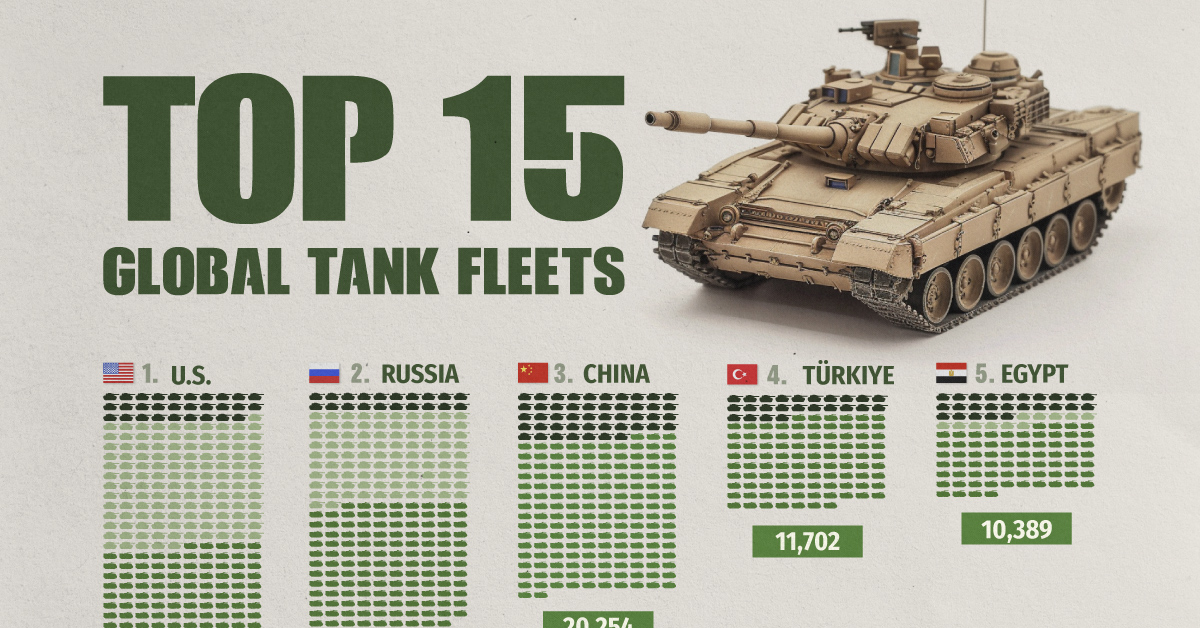
The Top 15 Global Tank Fleets
This was originally posted on our Voronoi app. Download the app for free on iOS or Android and discover incredible data-driven charts from a variety of trusted sources.
Heavily armed and armored, the modern tank is a versatile and mobile weapons platform, and a critical piece of contemporary warfare.
This visualization shows the top 15 global tank fleets, using data from the 2024 Military Balance report from the International Institute for Strategic Studies (IISS).
Let’s take an in-depth look at the top three fleets:
1. United States
As the world’s pre-eminent military power, it’s perhaps no surprise that the United States also has the largest tank fleet, by a wide margin.
In total, they have just over 45,000 armored fighting vehicles in operation, along with 2,640 main battle tanks (MBTs), and 12,800 vehicles in storage, of which 2,000 are main battle tanks.
| Category | Vehicles | Global rank |
|---|---|---|
| Main battle tanks | 2,640 | 4 |
| Armored reconnaissance | 1,745 | 1 |
| Infantry fighting vehicles | 3,262 | 3 |
| Armored personnel carriers | 10,644 | 1 |
| Amphibious assault vehicles | 1,401 | 1 |
| Armored utility vehicles | 28,445 | 1 |
| Storage | 12,800 | 1 |
| Total | 60,937 | 1 |
The U.S. is internalizing the lessons from the ongoing invasion of Ukraine, where Western-supplied anti-tank weapons and massed Ukrainian artillery have been cutting Russian tanks to pieces. As a result, the U.S. recently canceled an upgrade of the M1 Abrams in favor of a more ambitious upgrade.
Meanwhile, the U.S. is nervously eyeing a more confident China and a potential clash over Taiwan, where air and naval forces will be critical. However, a recent war game showed that Taiwanese mechanized ground forces, kitted out with American-made tanks and armored fighting vehicles, were critical in keeping the island autonomous.
2. Russia
According to Oryx, a Dutch open-source intelligence defense website, at time of writing, Russia has lost almost 2,800 main battle tanks since invading Ukraine. Considering that in the 2022 edition of the Military Balance, Russia was estimated to have 2,927 MBTs in operation, those are some hefty losses.
Russia has been able to maintain about 2,000 MBTs in the field, in part, by increasing domestic production. Many defense plants have been taken over by state-owned Rostec and now operate around the clock. Russia is also now spending a full third of their budget on defense, equivalent to about 7.5% of GDP.
At the same time, they’ve also been drawing down their Soviet-era stockpiles, which are modernized before being sent to the front. Just how long they can keep this up is an open question; their stockpiles are large, but not limitless. Here is what their storage levels look like:
| Category | 2023 | 2024 | YOY change |
|---|---|---|---|
| Main battle tanks | 5,000 | 4,000 | -20.0% |
| Armored reconnaissance | 1,000 | 100 | -90.0% |
| Infantry fighting vehicles | 4,000 | 2,800 | -30.0% |
| Armored personnel carriers | 6,000 | 2,300 | -61.7% |
| Total | 16,000 | 9,200 | -42.5% |
3. China
China holds the third overall spot and top place globally for the number of main battle tanks in operation. Untypically, the People’s Liberation Army has no armored vehicles in storage, which perhaps isn’t surprising when you consider that China has been rapidly modernizing its military and that stockpiles usually contain older models.
China also has one of the world’s largest fleets of armored fighting vehicles, second only to the United States. Breaking down that headline number, we can also see that they have the largest number of light tanks, wheeled guns, and infantry fighting vehicles.
| Category | Vehicles | Global rank |
|---|---|---|
| Main battle tanks | 4,700 | 1 |
| Light tanks | 1,330 | 1 |
| Wheeled guns | 1,250 | 1 |
| Infantry fighting vehicles | 8,200 | 1 |
| Armored personnel carriers | 3,604 | 5 |
| Airborne combat vehicles | 180 | 2 |
| Amphibious assault vehicles | 990 | 2 |
| Total | 20,254 | 3 |
This is equipment that would be integral if China were to make an attempt to reunify Taiwan with the mainland by force, where lightly armored mechanized units need to move with speed to occupy the island before Western allies can enter the fray. It’s worth noting that China also has one of the world’s largest fleets of amphibious assault vehicles.
End of the Tank?
Many commentators at the outset of Russia’s invasion of Ukraine, were quick to predict the end of the tank, however, to paraphrase Mark Twain, reports of the tank’s demise are greatly exaggerated.
With the U.S. and China both developing remote and autonomous armored vehicles, tanks could be quite different in the future, but there is nothing else that matches them for firepower, mobility, and survivability on the modern battlefield today.
-

 Technology2 weeks ago
Technology2 weeks agoRanked: The Most Popular Smartphone Brands in the U.S.
-

 Automotive1 week ago
Automotive1 week agoAlmost Every EV Stock is Down After Q1 2024
-

 Money1 week ago
Money1 week agoWhere Does One U.S. Tax Dollar Go?
-

 Green2 weeks ago
Green2 weeks agoRanked: Top Countries by Total Forest Loss Since 2001
-

 Real Estate2 weeks ago
Real Estate2 weeks agoVisualizing America’s Shortage of Affordable Homes
-

 Maps2 weeks ago
Maps2 weeks agoMapped: Average Wages Across Europe
-

 Mining2 weeks ago
Mining2 weeks agoCharted: The Value Gap Between the Gold Price and Gold Miners
-

 Demographics2 weeks ago
Demographics2 weeks agoVisualizing the Size of the Global Senior Population

